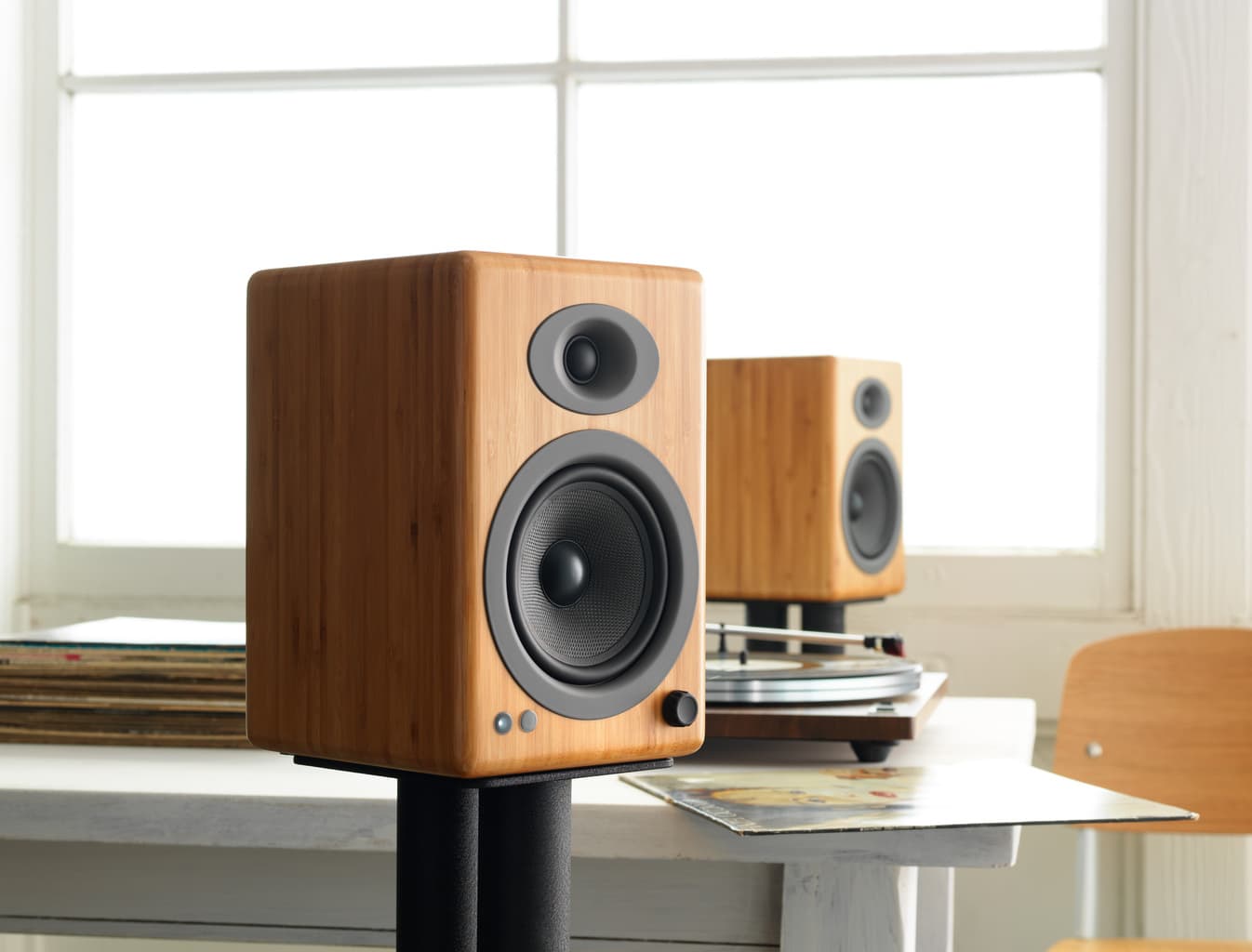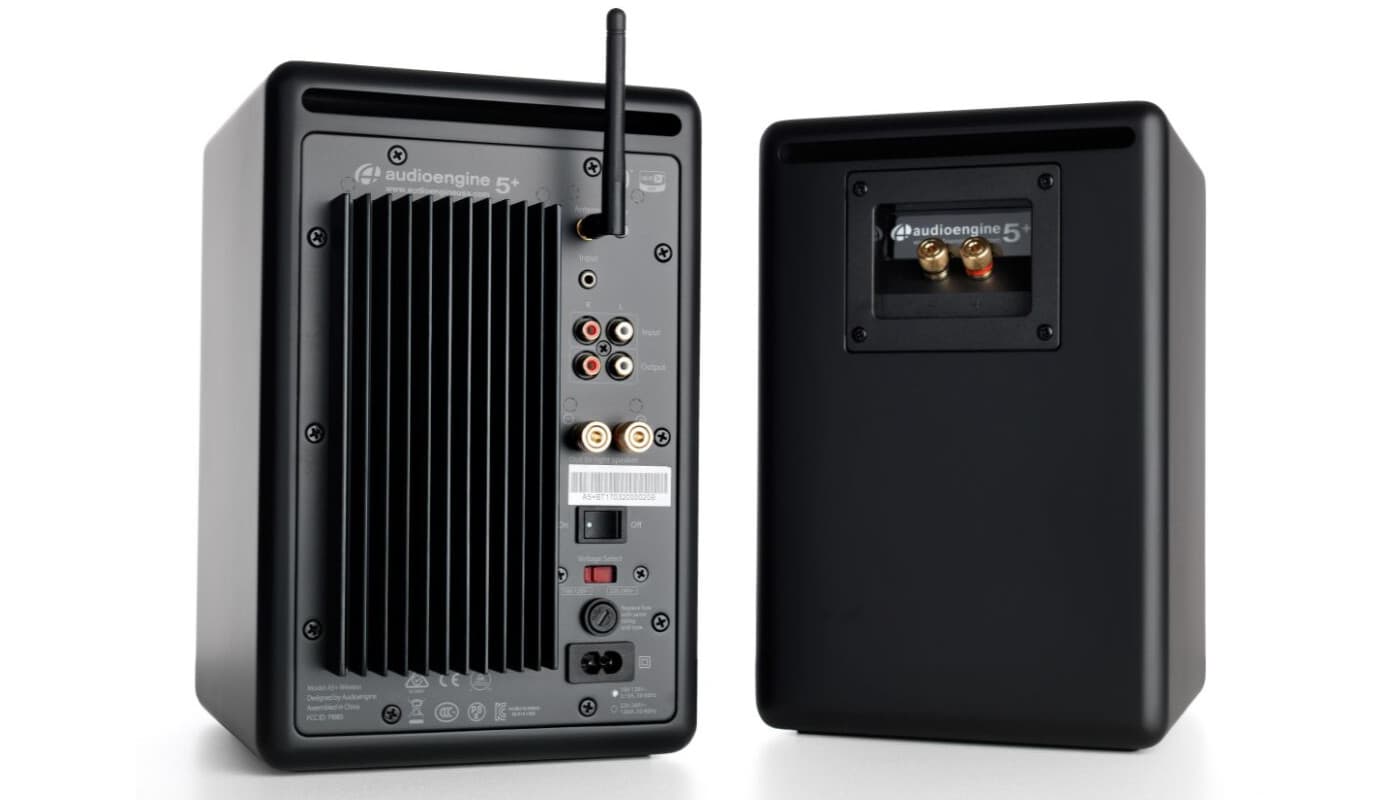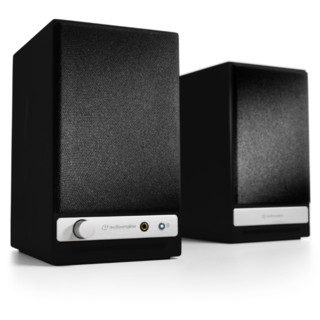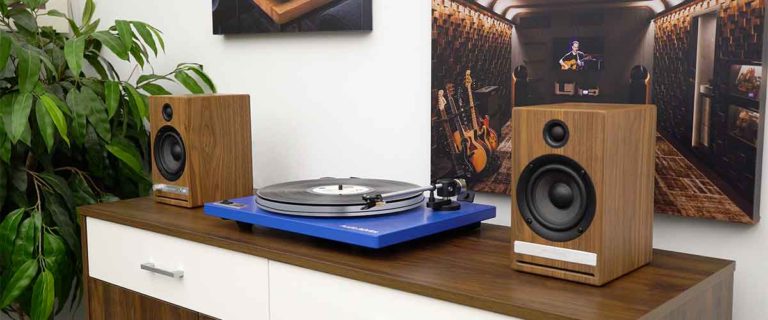It’s a real shame that bookshelf speakers have gone out of style. Although they’re fairly big and bulky, bookshelf speakers are awesome! It’s a classic look that has the potential to deliver great performance in a neat package. The Audioengine A5+ Wireless Speakers take the classic bookshelf look and pack it with in-house hardware and modern wireless tech.
Overview
- Price: $499.00
- Wattage: 150W (50W RMS, 75W peak per side)
- Connectivity: Bluetooth 5.0 (aptX, aptX HD, AAC, SBC), 3.5mm, RCA
- Dimensions: 27 x 18 x 20 mm (23mm on the left unit)
- Weight: 15.4 lbs left, 9.6 lbs right
- In the box: speakers, remote, antenna, 4m speaker wire, AC cord, 2 meter RCA cable, 2 meter 3.5mm cable, microfiber speaker and cable bags
The A5+ Wireless Speakers are almost identical, though the left houses a few extra features. There is a status light and an IR receiver side-by-side with a volume knob nearby. The status light is coated in darkened plastic so it’s dimmed and diffused.
On the back is where you see the main difference. The right speaker contains just the drivers in the cabinet, with the bass slit up top and the two banana jack receptacles for the speaker wire connecting the two speakers together.
The left speaker has a massive heatsink that houses the dual class AB analog amplifier and keeps it cool. All the connections are there as well, such as RCA and 3.5mm inputs, an RCA output for a sub, the output banana jacks, a power switch, a voltage selector, a fuse, and the AC power inlet. Under the bass port you’ll find a Bluetooth antenna and a pair button. The inputs can be used simultaneously; there is no switch.
Notice how there isn’t a single logo on the front, sides, or top of these speakers. It makes for a wonderfully clean look.
Build quality
Build quality isn’t important for stationary speakers in the traditional sense. A good feel is irrelevant, since you won’t really be touching them. However, quality materials and assembly make a massive difference in audio performance. And of course you want them to look nice!
The A5+ Wireless Speakers are made out of handcrafted 1/2-inch thick wood (MDF) and finished in either satin black, gloss white, or carbonized bamboo if you want to spend a little extra. This is the gloss white model, and despite being bookshelf speakers (which generally look rather average), the round corners and gloss white paint really look beautiful and modern. I love the choice of gloss finish.
Everything about these speakers is well put together. The cabinets are extremely solid. The back panels are properly fastened without any flex. The connectors are high quality. Of course, this is all stuff you’d expect to be done right.
The volume knob on the front is tight and has a satisfying resistance and click. It also pushes in to put the speakers to sleep.
The remote is something special. It’s made out of a single piece of milled-out aluminum with a brushed finish and heavy texture. It’s surprisingly solid feeling and the chamfered edges make it feel oh so premium. The buttons themselves feel just a bit cheap though.
To change the battery, you have to pop out the entire center remote section with a SIM tool or paper clip, revealing a bright red circuit board with an Audioengine logo and a coin cell battery. Inside the housing are four magnets that hold the board in. It’s definitely super cool and the attention to detail should not be overlooked.
One detail I quite like is that the speakers come in really nice microfiber speaker bags. The cables come in their own little microfiber bag. This is great for transporting them, but even if they’ll remain stationary, it’s a really nice touch.
Sound quality
There are a lot of different types of speakers on the market. Some are rugged, some are portable, some are straight up art. But the Audioengine A5+ Wireless Speakers are all function. Bookshelf speakers usually are.
And let me tell you, they sound amazing. The sound signature is relatively flat and balanced yet still sounds interesting and fun enough for regular people to love it.
Audioengine utilizes custom aramid fiber woofers, silk tweeters, and a dual class AB analog amplifier. The analog distinction is important, as most amps these days are digital. The debate between digital and analog will never end, but many say analog is superior in many use cases. It’s also nice to see all custom parts engineered to work together rather than off the shelf parts.
When at very low volumes, they sound flat and accurate. They’re one of the most “accurate” speakers I’ve ever tested, while most others are heavily colored, with boosted highs or bass. At very low volumes they’re almost a little clinical. This is usually augmented with a standalone subwoofer, which these speakers don’t need but can utilize thanks to an audio output for this purpose. I firmly believe a powered sub isn’t necessary here, but if you want it, Audioengine does sell the S8 Powered Subwoofer for $349.
When you turn them up, they really come alive. The bass is shockingly strong. For strong bass you’d usually see massive dedicated woofers and big ports, yet these speakers do without all that. You can get rib-shaking bass from these things with no tweaks to the EQ. And no matter how high you turn them up, they stay clear and sharp.
And they go loud! It’s easy to fill a medium-sized room with such loud sound you can’t yell over it. Distortion is basically nonexistent, too. Highs are sharp and accurate but never grating, and mids are full and powerful. It’s really a lovely sound signature and a breath of fresh air when every other speaker turns the treble up to 11 and the bass gets muddy from boosting.
They’re not just great for music either. Gaming on them is a pleasure. Gears of War (a game with wonderful sound design and incredible sound effects) especially sounds amazing, with punchy bass from every explosion and a sharp smack when you hit a wall after a roadie run.
Keep in mind that your source signal matters here. These are fully analog speakers, so your source signal is what gets amplified and played. If your device’s analog output is noisy or simply no good, the final audio won’t be as good. That’s not to say that the average computer or device will sound bad (it won’t!), but a quality signal matters. All my testing was done either through a Creative Sound BlasterX G5 DAC or via Bluetooth devices that supported aptX HD.
The downside to the analog amp is that you get no digital inputs. There’s no optical, so you can’t directly use them with your DVD player or Xbox. This is unfortunate, but a receiver can fix that.
Keep in mind that, unlike with a sound bar, positioning of a bookshelf speaker is very important. You’ll ideally want them spread far apart and at the height of the listener’s ear. You also want a bit of space behind them, so don’t actually put them on bookshelves if you can avoid it. Play with positioning and watch your audio experience change.
Wireless
Wireless is about as simple as you’d expect from Bluetooth. There’s no setup, just plug them in and pair them with your phone. The good news is that Audioengine used the aptX HD codec, which delivers “higher than CD quality” audio at up to 24-bit/48kHz. Most people may never hear the difference between Bluetooth via aptX HD and a quality wired connection. Don’t worry if your device has aptX but not aptX HD; these speakers work with regular aptX too.
One gripe I have is that every time you turn the speakers on, they’ll automatically connect to your smartphone. This can get annoying as every time you come home, your phone auto connects and you lose all audio through the device’s own speaker. Devialet managed to allow a manual Bluetooth connection without autoconnect, and I wish Audioengine did too.
Otherwise, the wireless functionality is stellar. Signal is great and never skips, quality is fantastic, and ease of use could not be better. While a built-in Chromecast is superior for audio streaming, it adds a lot of expense because of the Chromecast internals, a WiFi setup and antennas, and a setup process. This is dead simple and functional.
Conclusion
The Good
- Fantastic, flat sound
- Gorgeous gloss white finish
- Wireless connectivity is strong
- Really sexy remote
The Bad
- Bass is weak at low volumes
- Bluetooth auto reconnects
- Take up a lot of space on a desk
There’s something to be said for speakers that are built for pure performance. The Audioengine A5+ Wireless Speakers sound fantastic, but they’re not wildly expensive or out of reach for the average person. If you care about audio, dropping $500 on a quality set of speakers that will last you for years (maybe decades) to come isn’t crazy. We spend more on our phones every year or two.
The sheer attention that Audioengine puts into their speakers is surprising. Custom drivers, hand-built wooden cabinets (with that gorgeous white gloss finish!), an analog amplifier, the inclusion of aptX HD, and the simplicity of use all make for a great speaker.
Let’s bring bookshelf speakers back into style.
Read full review here.











